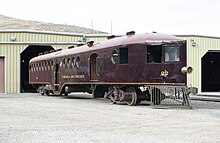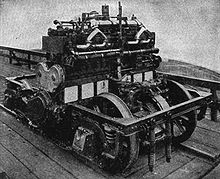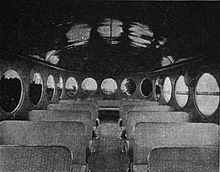McKeen railcar

The McKeen Motor Car Company's railcars were among the first commercially successful railroad locomotives with an internal combustion engine . The combustion railcars were built in the United States from 1905 to 1917 in various variants in a total of 152 copies, plus a few sidecars.
history
In order to improve the economy of passenger traffic on the branch lines of the Union Pacific Railroad , the chairman and owner of the company Edward Henry Harriman commissioned the "Superintentent of Motive Power and Machinery" William Riley McKeen in 1904 to develop a railcar with a combustion engine. At this point in time, Union Pacific had no experience of building such a vehicle.
The first vehicle UP M-1 was still two-axle. It took off on March 7, 1905 for its first test drive from Omaha to Valley (Nebraska) . Then more trips followed. On August 21, 1905, the first regular passenger traffic by vehicle between Kearney (Nebraska) and Callaway (Nebraska) , 100 kilometers away , began.
This first vehicle was followed by a further seven railcars by 1908. These ran on two bogies and were much longer. Due to the success of the test drives carried out with the vehicles, the Union Pacific Railroad and the Southern Pacific Railroad ordered a larger number of the railcars. As a result, McKeen Motor Car Company was formed on July 1, 1908, with registered capital of $ 1 million. William McKeen became president of the society. The company rented factory buildings in Omaha from the Union Pacific.
Railcars have been supplied to over 41 railroad companies in the United States.
In 1910 the export of railcars began. This year two vehicles were shipped to Victorian Railways in Australia. Two years later, six railcars for the Australian Queensland Government Railways followed . Further exports were made to Canada, Cuba, Mexico and Spain.
However, it turned out that the mechanical power transmission was structurally not fully developed and was at a disadvantage compared to the benzene-electric railcars from General Electric .
As groundbreaking as the McKeen wagons were in some ways, they caused some problems in operation. The few further developments did not solve the teething problems.
Due to the lack of compressors and because of the only one driving axle - wheel arrangement (A1) 2 '- the cars started very poorly. The lack of reverse gears made any maneuvering difficult. The marine engines and the in-house developments based on marine engines did not withstand the hard vibrations that are inevitable in land vehicles. Most railcars became inoperable after a few years. Some operators equipped them with new engines and gearboxes or diesel-electric drives, others later used them as non-powered passenger coaches.
Orders continued to decline and the last vehicles were manufactured in 1917. The Union Pacific Railroad therefore decided to liquidate the McKeen Motor Car Company.
The workshops of the Union Pacific made two railcars (M-26 and M-27) in 1923 and two more (M-29 and M-30) in 1927 from existing parts and the engines of scrapped vehicles.
Vehicle list
Constructive features
The six-cylinder engine lay on the front bogie ( machine bogie ) and only drove the leading set of wheels, the wheels of which were slightly larger than the others. The starter was operated with compressed air. The engines of the first seven cars were marine engines from the Standard Motor Works in Jersey City and had an output of 75 kilowatts.
From the eighth railcar, McKeen built in self-developed engines with 225 kW. As was common in shipbuilding at the time, there was no reversing gear . Instead, the engine had a sliding camshaft with two sets of cams. To change the direction of travel, the engine had to be switched off, whereupon the machinist shifted the camshaft so that the other set of cams engaged. The engine was then started again in the opposite direction of rotation.
The wagons themselves were 16.76 meters (55 feet) long in the standard version with 54 seats, some with 75 seats 21.36 meters (70 feet) in length (without coupling and rail clearing in the form of the typical American "cow catcher"). Additional mail and other sidecars were delivered with a length of only 9.45 meters.
The floor frame was made of steel and carried a structure also made of steel parts.
Most vehicles had a streamlined shape with a tapered front section and a rounded rear with a semicircular bench. In keeping with this boat-like shape, the windows in the passenger compartment were usually round like portholes . Some cars had a mail compartment between the engine compartment and the passenger compartment . In most of the cars, doors on the central platform, which was lowered to the side, enabled passengers to get on and off easily. The passenger compartment was furnished with wood paneling and elegant seats.
In the standard version, the lighting was initially carried out with carbide lamps . Few of the cars had electric lighting from the start, and a large number were converted over time.
Received vehicles
Of the more than 150 vehicles produced, three have survived:
- A vehicle found in Alaska and delivered to the Yuma Valley Railroad in 1910 is in a badly damaged, unrestored condition.
- Railcar No. 22, delivered to the Virginia and Truckee Railroad in 1909, was refurbished from 2006 to 2010. The McKeen railcar is now owned by the Nevada State Railroad Museum . In October 2012 it was added to the National Historical Register.
- The Nevada State Railroad Museum also has the remains of another railcar.
literature
- Edmund Kielty: Interurbans Without Wires . Interurban Press, Glendale, California 1979, ISBN 0-916374-38-6 .
- Hilton, George W .; Due, John F. (1960,2000). The Electric Interurban Railways in America. Stanford, California: Stanford University Press. ISBN 0-8047-4014-3 .
- William W. Kratville: Knife-noses and portholes . In: Trains . Kalmbach Publishing Co., July 1960, ISSN 0041-0934 , p. 30-39 .
Web links
- Mc Keen Motor Car Company bibliography
- Information on the vehicles at utahrails.net (Engl.)
- detailed representation of the McKeen wagons on a local history page
- McKeen wagons on a side across Alaska Railroad
- Photos of the V&T No. 22
- Photos and links to patent drawings
Individual evidence
- ^ Virginia and Truckee Railroad McKeen Motor Car No. 22. Restoration Program. (No longer available online.) In: Carson City RR Museum. Nevada Division of Museums and History, archived from the original on February 3, 2013 ; accessed on December 31, 2012 . Info: The archive link was inserted automatically and has not yet been checked. Please check the original and archive link according to the instructions and then remove this notice.
- ↑ Interior Designates 27 New National Landmarks. US Department of the Interior, October 17, 2012, accessed on December 31, 2012 : "This is the best surviving example of the first commercially viable application of internal combustion power in a self-propelled railroad car."



